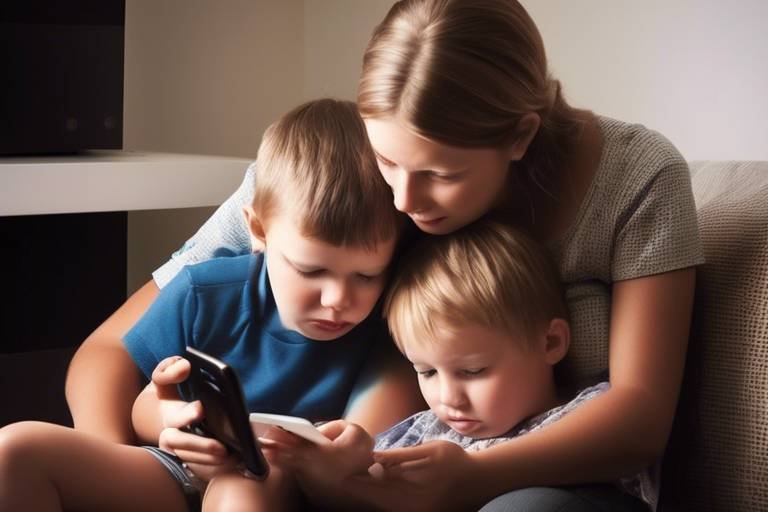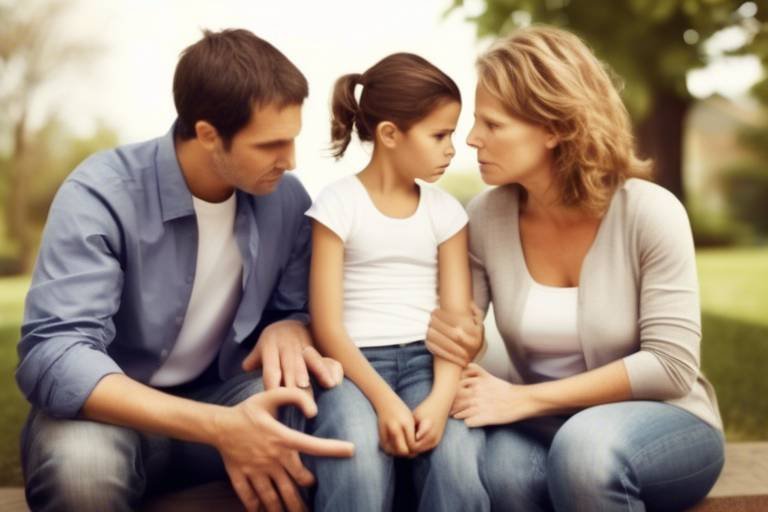Dealing with Loss of Pets: A Guide for Families
The loss of a pet is a heart-wrenching experience that can leave families feeling lost and devastated. Our furry friends are not just animals; they are members of our family, companions who provide unconditional love and joy. When they are gone, it can feel as if a part of our hearts has been ripped away. This article aims to provide support for families coping with the loss of a beloved pet, offering insights on grief, memorializing pets, and finding closure during this difficult time.
Grieving the loss of a pet is a profound experience that can manifest in various emotional stages. Initially, families may experience shock and disbelief, feeling as if their beloved companion is still with them. As reality sets in, feelings of sadness and anger may emerge, often accompanied by guilt or regret. It's essential to understand that this emotional rollercoaster is a normal part of the grieving process. Each family member may experience these stages differently, and it's crucial to allow space for everyone to express their feelings.
Grief can also affect daily routines and relationships. Family members might withdraw or become irritable, leading to misunderstandings. Recognizing these changes can help families support one another. Remember, it’s okay to grieve, and it’s okay to talk about your feelings. Open conversations about your pet can provide comfort and help families navigate their grief together.
Children often struggle to grasp the concept of death, and losing a pet can be particularly confusing for them. It’s vital for parents to approach this sensitive topic with care. One effective way to help children cope is by explaining the loss in an age-appropriate manner. For younger children, simple explanations about the pet being in a better place can be comforting. For older children, discussing the biological aspects of death might be more suitable.
It's essential for children to express their emotions regarding the loss of their pet. Parents can encourage this expression through various activities. For instance, creating a memory box filled with photos and mementos of the pet can be a therapeutic way for children to remember their furry friend. Additionally, parents can engage children in conversations about their feelings, asking questions like, "What do you miss the most about [pet's name]?" This can help children articulate their emotions, promoting healing.
Art, writing, and play can be incredibly therapeutic for children dealing with grief. Encouraging kids to draw pictures of their pet or write letters to them can provide an outlet for their feelings. These creative outlets allow children to express their grief and remember their pets in a positive way. For example, a child might create a scrapbook filled with their favorite memories, which can serve as a beautiful tribute to their beloved companion.
Facilitating open discussions about death can help children understand the concept of loss better. Parents can approach these conversations by being honest yet gentle. Using books about pet loss can also be a helpful resource, providing a framework for discussion. It’s essential to reassure children that it’s okay to feel sad and that their feelings are valid. This open dialogue fosters a safe environment for children to process their emotions.
Creating rituals or memorials can provide families with a sense of closure. This can be as simple as holding a small ceremony in the backyard or planting a tree in memory of the pet. Families can also create a memorial space in their home with pictures and items that remind them of their pet. These rituals reinforce the bond shared and help with the healing process, allowing families to celebrate the life of their beloved companion.
Sometimes, grief can be overwhelming, and it’s important to recognize when additional support is needed. Seeking professional help can provide families with tools to cope with their loss. Therapists specializing in grief counseling can offer a safe space for family members to express their feelings and navigate their grief journey. It's essential to remember that asking for help is a sign of strength, not weakness.
Support groups can be incredibly beneficial for families dealing with the loss of a pet. These groups offer community and understanding, allowing families to share their experiences and feelings in a safe environment. Joining a pet loss support group can help families realize they are not alone in their grief, providing a sense of belonging and shared understanding.
Various resources can aid in coping with loss. Books, websites, and hotlines dedicated to pet loss can provide additional support and information for families navigating their grief journey. Here are a few recommended resources:
- Books: "Goodbye, Friend" by Gary Kowalski
- Websites: The Association for Pet Loss and Bereavement (APLB)
- Hotlines: Pet Loss Support Hotline
Q: How can I help my child cope with the loss of a pet?
A: Encourage open conversations, create memory boxes, and engage in creative activities to help your child express their feelings.
Q: Is it normal to feel guilty after losing a pet?
A: Yes, feelings of guilt are common. It’s important to acknowledge these feelings and talk about them with family or a professional.
Q: When should I seek professional help for my grief?
A: If grief is overwhelming and affecting daily life, it may be time to seek professional support.

Understanding Grief and Loss
Grieving the loss of a pet is a profound experience that can shake the very foundation of a family. When a beloved animal companion passes away, it’s not just the pet that’s lost; it’s the joy, companionship, and unconditional love they provided. This emotional journey can be overwhelming, leaving families feeling lost and unsure of how to navigate their grief. It’s essential to understand that grief is a natural response to loss, and it manifests in various ways, often resembling the stages of human grief.
Initially, families may experience shock and denial. This stage can feel surreal, as if the loss hasn’t truly occurred. You might catch yourself expecting to see your furry friend curled up in their favorite spot or waiting by the door for your return. Following this, families often move into anger, which may be directed at themselves, others, or even the circumstances surrounding the pet’s passing. It’s a way of expressing the helplessness and frustration that comes with such a painful loss.
As the grieving process continues, bargaining may set in. Families might find themselves replaying scenarios in their minds, wondering if they could have done something differently to prevent the loss. This stage is often followed by depression, where the weight of the loss feels particularly heavy. It’s common to withdraw from activities that once brought joy, as the absence of the pet creates an emotional void. Finally, acceptance emerges, allowing families to begin healing and cherish the memories of their beloved pet.
It’s important to note that these stages don’t necessarily occur in a linear fashion. Families may cycle through them multiple times, and that’s perfectly normal. Each person grieves differently, and there’s no right or wrong way to process loss. Some may find solace in sharing stories about their pet, while others might prefer solitude. The key is to allow space for these feelings and to support each other through the journey.
In many cases, families might find it helpful to create a memory table that honors their pet. This could include photographs, toys, and other mementos that remind them of the joyful times spent together. Here’s an example of what such a table might look like:
| Memory Item | Description |
|---|---|
| Photo Album | A collection of pictures capturing memorable moments with your pet. |
| Favorite Toy | The toy your pet loved to play with, symbolizing their playful spirit. |
| Collar | The collar that represents your pet’s unique personality. |
Creating such tangible reminders can help families feel connected to their pet, even in their absence. By understanding the complexities of grief and loss, families can foster an environment where emotions are expressed freely, allowing for healing and closure over time.

Helping Children Cope
When a family pet passes away, it’s like losing a member of the family. Children, in particular, can find it incredibly challenging to navigate the waves of emotions that come with such a loss. They often don’t fully grasp the concept of death, making it essential for parents to approach the situation with care and compassion. How can we help our kids understand and cope with this heart-wrenching experience? The key lies in open communication and providing age-appropriate explanations that can help demystify the process of grief.
One of the most effective ways to support children during this difficult time is by encouraging them to express their feelings. Emotions can be overwhelming, and kids may not know how to articulate their sadness, confusion, or anger. Engaging them in activities like drawing, writing, or even role-playing can provide a safe space for them to explore their emotions. For instance, you might suggest they create a story about their pet or draw pictures that represent their favorite memories together. These creative outlets can serve as a therapeutic means for children to process their grief.
It's crucial for children to feel comfortable sharing their feelings, and as parents, we can foster this environment. Here are some strategies to encourage emotional expression:
- Set aside time each day for open conversations about their feelings.
- Use books or stories about pet loss to initiate discussions.
- Encourage journaling or drawing as a way to express emotions.
By creating a routine where children can openly discuss their feelings, you help them feel less isolated in their grief. It's like giving them a lifeline in a stormy sea of emotions.
Art, writing, and play are not just activities; they can be powerful tools for healing. Children often express themselves better through creative means than through words alone. For instance, you could set up a small memorial area in your home where they can place their drawings or poems dedicated to their pet. This space can serve as a constant reminder of the love shared, helping to keep the pet's memory alive while also promoting healing.
Facilitating open discussions about death can be daunting for parents, but it’s essential for helping children understand loss. Here are some tips for approaching these sensitive conversations:
- Use clear, straightforward language that matches their age and comprehension level.
- Be honest about your feelings and share your own grief.
- Encourage questions and provide thoughtful answers, even if they are difficult.
By normalizing conversations about death, you equip your children with the tools they need to process their grief. Think of it as planting seeds of understanding that will grow into a more profound comprehension of life and loss.
In conclusion, helping children cope with the loss of a pet is a journey that requires patience, empathy, and creativity. By encouraging emotional expression, utilizing creative outlets, and fostering open conversations, we can guide our children through this challenging time, helping them heal while honoring the memory of their beloved companions.

Encouraging Expression of Feelings
When a pet passes away, it can leave a huge hole in the hearts of everyone in the family, especially the children. It's like losing a little piece of sunshine that brightened their days. Encouraging children to express their feelings about this loss is crucial for their emotional healing. But how do you go about this? It can be a delicate balance, and every child will handle grief differently. The goal is to create a safe space where they can share their emotions without fear of judgment.
One effective way to encourage expression is through creative activities. Art can be a powerful tool for children. You might set up a small art station with crayons, markers, and paper, allowing them to draw or color their feelings. For example, they could create a picture of their pet or draw a scene that reminds them of happy times spent together. This not only provides an outlet for their emotions but also opens the door for conversations about their feelings. You could say, “What do you think your pet would say about your drawing?” This invites them to share their thoughts and feelings more openly.
Another fantastic method is through storytelling. Encourage your child to write a story about their pet, recounting the adventures they had together. This could be a simple narrative, or you could help them create a scrapbook filled with photos and memories. Writing stories can help children process their grief and cherish the good times they shared with their furry friend. It’s like creating a treasure chest of memories that they can revisit whenever they want.
Additionally, facilitating open conversations about their feelings is essential. You might say, “It’s okay to feel sad; it shows how much you loved your pet.” This simple acknowledgment can validate their emotions and help them feel understood. Children often think they need to be strong or hide their feelings, so reminding them that it’s normal to feel a mix of emotions can be liberating.
Moreover, consider incorporating a grief journal. This can be a special notebook where your child can write down their thoughts, feelings, or even letters to their pet. Encourage them to express their emotions freely, whether it’s sadness, anger, or even joy when remembering the fun times. This journal can serve as a private space for them to reflect and process their grief over time.
Lastly, don’t underestimate the power of play. Sometimes, children may not want to talk about their feelings directly, but they might express themselves through play. Engaging in role-playing games or using toys to act out scenarios can help them articulate their emotions in a way that feels safe and manageable. For instance, they might create a story with their stuffed animals that mirrors their experience, allowing them to explore their feelings in a non-threatening manner.
In conclusion, encouraging children to express their feelings about the loss of a pet is a vital part of the healing process. By providing creative outlets, fostering open conversations, and allowing them to play, you can help them navigate their emotions more effectively. Remember, it’s all about creating a supportive environment where they feel comfortable being themselves and sharing their feelings.

Creative Outlets for Grieving
When a beloved pet passes away, it can feel like a piece of our heart has been ripped away. For children, this experience can be even more challenging to navigate. One effective way to help them cope with their grief is through creative outlets. Engaging in activities such as art, writing, and play not only provides a therapeutic escape but also allows children to express their emotions in a safe and constructive manner. Just as a painter uses colors to express their feelings on canvas, children can use various mediums to articulate their grief.
For instance, artistic expression can take many forms. Drawing or painting pictures of their pet can serve as a beautiful tribute. Children might create a colorful portrait or a scene depicting their favorite memory with their furry friend. This not only helps in processing their emotions but also gives them a tangible way to remember the joy their pet brought into their lives. Additionally, creating a scrapbook filled with photographs and mementos can be a wonderful way to celebrate the life of their pet.
Writing can also be a powerful tool for healing. Encourage children to write letters to their pet, sharing their thoughts and feelings. This can be a cathartic process, allowing them to say goodbye in their own words. They might also enjoy writing stories or poems about their pet, which can help them reflect on their happy memories. This kind of writing can serve as a keepsake, capturing the essence of their bond.
Play is another essential outlet for children dealing with grief. Through imaginative play, children can reenact scenarios that help them process their feelings. For example, they might create a memorial service for their pet with their toys, allowing them to explore the concept of loss in a safe environment. Such play not only fosters understanding but also reassures them that it’s okay to feel sad and miss their pet.
Ultimately, the goal of these creative outlets is to provide children with a means to express their grief openly. It's important for parents to be involved in these activities, offering support and encouragement. By participating in these creative processes together, families can strengthen their bonds and create a shared space for healing. Remember, grief is a journey, and allowing children to express themselves creatively can make that journey a little lighter.
- How can I encourage my child to express their feelings about losing a pet?
Engaging in creative activities like drawing, writing, or even storytelling can help children articulate their emotions. Be open to discussing their feelings and offer support during these activities.
- What are some appropriate rituals to honor a pet's memory?
Creating a scrapbook, holding a small memorial service, or planting a tree in their memory can be meaningful ways to honor a pet.
- When should I seek professional help for my child’s grief?
If your child shows prolonged signs of distress, such as difficulty sleeping or persistent sadness, it may be beneficial to consult a professional.

Open Conversations About Death
Talking about death can feel like navigating a minefield, especially when it comes to our little ones. However, having is crucial for helping children understand and process their feelings about losing a beloved pet. It’s not just about the loss itself; it’s about fostering a safe space where children can express their emotions and ask questions without fear. So, how do we approach this sensitive topic?
First and foremost, it’s important to create an environment where children feel comfortable sharing their thoughts. You might start by gently introducing the subject. For instance, you can say something like, “You know how we talk about all the happy memories we have with [Pet's Name]? Sometimes, pets get very sick, and they can’t get better. This can make us very sad.” This simple statement opens the door for discussion and lets them know it’s okay to feel upset.
As you talk, be prepared for a range of questions. Kids are naturally curious, and they might ask things like:
- “Why did [Pet's Name] have to go?”
- “Will they come back?”
- “What happens when pets die?”
Answering these questions honestly, yet gently, can help them come to terms with the reality of death. You don’t have to have all the answers, and it’s perfectly okay to say, “That’s a great question. I’m not sure, but I think…” This approach not only validates their feelings but also encourages them to think critically about the situation.
Moreover, using age-appropriate language is key. Younger children may not grasp complex concepts, so keeping things simple is essential. For example, instead of saying “passed away,” you might explain that their pet “went to sleep and won’t wake up.” This can help them understand without overwhelming them with too much information at once.
Another effective way to facilitate these conversations is through storytelling. You can share stories about your own experiences with loss, perhaps from your childhood. This not only makes the conversation relatable but also shows them they’re not alone in their feelings. You might say, “When I lost my childhood pet, I felt really sad, too. It’s okay to feel that way.”
Finally, remember that these conversations don’t have to happen all at once. Grief is a process, and children may need time to digest what you’ve discussed. Be open to revisiting the topic whenever they bring it up, and encourage them to express their feelings through various outlets, such as drawing or writing. This ongoing dialogue can significantly help them in their journey of understanding and healing.
In essence, open conversations about death are not just about discussing the loss of a pet; they are about building emotional resilience in children. By addressing their feelings head-on and providing a supportive atmosphere, you’re equipping them with the tools they need to navigate their grief, ultimately allowing them to cherish the memories of their furry friend.
Q: How do I know if my child is ready to discuss the death of our pet?
A: Look for signs of curiosity or sadness in your child. If they mention the pet or seem to be processing their feelings, it may be a good time to start the conversation.
Q: What if my child doesn’t want to talk about it?
A: That’s perfectly normal. Give them space and let them know you’re available to talk whenever they feel ready. Sometimes, children express their feelings through play or art instead of direct conversation.
Q: Should I use the word “death” when talking to my child?
A: It depends on your child’s age and understanding. Using clear but gentle language can help them grasp the concept without causing unnecessary fear.
Q: How can I help my child remember our pet positively?
A: Encourage them to create a memory book, draw pictures, or share stories about their pet. Celebrating the pet’s life can help shift the focus from loss to love.

Rituals and Memorials
When a beloved pet passes away, the emotional toll can be immense, and finding ways to honor their memory can be a crucial step in the healing process. serve not only as a tribute to the life of your pet but also as a way for families to come together, reflect, and find comfort in shared memories. These acts can provide a sense of closure and help to reinforce the bond that was shared. It's important to remember that there is no right or wrong way to memorialize a pet; what matters is that it resonates with you and your family.
One of the simplest yet most meaningful ways to memorialize a pet is through a memory box. This can be a special container where you keep items that remind you of your pet, such as their collar, favorite toys, or photographs. As you place each item inside, take a moment to reflect on the memories associated with it. This not only keeps the memory alive but also serves as a tangible way to process your grief.
Another beautiful ritual is to create a memorial garden. This can be a small space in your yard or a pot on your balcony where you plant flowers or shrubs in honor of your pet. Choose plants that were meaningful to your pet, or simply select those that bring you joy. Every time you tend to the garden, you’ll be reminded of your pet’s spirit and the happiness they brought into your life.
For families who enjoy being creative, consider organizing an artistic tribute. This could be a family art project where each member creates something that represents their feelings about the pet. Whether it's a painting, a poem, or a sculpture, these creative outlets can be incredibly therapeutic, allowing everyone to express their grief in a personal and unique way.
Additionally, holding a memorial service can provide a space for family and friends to gather and share stories about the pet. This can be as simple or elaborate as you choose. You might light candles, share favorite memories, or even play a song that reminds you of your pet. The act of coming together in remembrance can be profoundly healing.
Finally, consider making a donation to an animal charity or shelter in your pet's name. This not only honors your pet's memory but also helps other animals in need. It’s a way to turn your grief into something positive, creating a legacy that continues to give back.
In summary, rituals and memorials are powerful tools for coping with the loss of a pet. They allow families to celebrate the life of their furry friend while also facilitating the healing process. Whether through memory boxes, gardens, artistic tributes, memorial services, or charitable donations, finding a way to honor your pet can help you navigate the complex emotions associated with their passing.
- What is the importance of memorializing a pet? Memorializing a pet helps to acknowledge the bond shared and provides a way to process grief.
- How can I involve my children in memorializing our pet? Encourage them to create art, write letters, or participate in memorial activities to express their feelings.
- Are there professional services for pet memorials? Yes, many pet cemeteries and memorial services offer options for burial, cremation, and memorialization.

Seeking Professional Help
Sometimes, the emotional weight of losing a pet can feel like a heavy blanket, suffocating and overwhelming. It's completely normal to feel this way, and acknowledging these feelings is the first step towards healing. But what happens when the grief becomes too much to bear? When the sadness lingers longer than expected, or when it starts to interfere with daily life? This is where seeking professional help can make a world of difference.
Professional counselors and therapists are trained to help individuals navigate their emotions during tough times. They can provide a safe space for you and your family to express your feelings openly without judgment. Whether it's through one-on-one sessions, family therapy, or group counseling, these professionals can equip you with tools to cope with your grief. It's important to remember that reaching out for help is not a sign of weakness; instead, it shows strength and a willingness to heal.
When considering professional help, you might wonder what options are available. Here are a few avenues to explore:
- Individual Therapy: A therapist can work with you one-on-one to explore your feelings and develop coping strategies.
- Family Counseling: This can help families process their grief together and strengthen their emotional bonds.
- Support Groups: Joining a group of people who have experienced similar losses can provide comfort and understanding.
But how do you know when it's time to seek help? Look for signs such as persistent sadness, difficulty functioning in daily life, or a feeling of isolation. If you find yourself overwhelmed with emotions or unable to move forward, it may be time to consult a professional. Remember, it’s okay to ask for help; it shows your commitment to healing and honoring your pet’s memory.
In addition to traditional therapy, there are also specialized resources available for pet loss. Many organizations offer hotlines and online support groups specifically for grieving pet owners. These resources can provide immediate support and connect you with others who understand the pain you're experiencing. Consider reaching out to organizations like the ASPCA or the Pet Loss Support Hotline for guidance and support.
Ultimately, seeking professional help can be a crucial step in the healing process. It can help you find closure and allow you to cherish the memories of your beloved pet without being consumed by grief. Remember, you are not alone in this journey; there are professionals and communities ready to support you every step of the way.
Q: How do I find a therapist who understands pet loss?
A: Look for therapists who specialize in grief counseling or have experience with pet loss. You can check online directories or ask for recommendations from your veterinarian or local animal shelters.
Q: What should I expect in a therapy session?
A: In a therapy session, you can expect to discuss your feelings and experiences regarding your pet's loss. The therapist will listen, provide support, and help you develop coping strategies.
Q: How long does the grieving process take?
A: Grieving is a personal journey and varies for everyone. There is no set timeline, and it's important to allow yourself to feel and process your emotions at your own pace.

Finding Support Groups
When faced with the heartbreaking loss of a pet, it’s easy to feel isolated in your grief. Many families find solace in connecting with others who understand their pain. Support groups can be a beacon of hope during these dark times, providing a safe space to share experiences, emotions, and memories. But how do you find the right support group for your family? Here are some tips to guide you.
First and foremost, consider looking for local pet loss support groups. These groups often meet in person, allowing participants to share their stories face-to-face. You can check with local veterinary offices, animal shelters, or community centers that may host such gatherings. Many of these groups are led by trained facilitators who understand the nuances of pet loss and can guide discussions in a healing direction.
If local options are limited, don't worry! The internet is a treasure trove of resources. Numerous online support groups are available, offering forums, chat rooms, and virtual meetings. Websites like PetLoss.com and Grieving Pet provide platforms where you can connect with others who are navigating similar grief. Online groups can be incredibly beneficial, especially for those who may feel uncomfortable discussing their feelings in person.
In addition to traditional support groups, consider looking into social media communities. Platforms like Facebook host various groups dedicated to pet loss. These groups can offer daily support and allow members to share their memories, photos, and stories in a judgment-free environment. Just remember to choose groups that are moderated to ensure a positive and supportive atmosphere.
It’s important to find a group that resonates with you and your family. Don’t hesitate to try out a few different groups before settling on one that feels right. Each group has its unique dynamics, and finding the right fit can make all the difference in your healing journey. Some groups focus on specific types of pets, while others are more general. The goal is to find a community where you feel comfortable expressing your grief.
Lastly, if you’re unsure where to start, reach out to a therapist or counselor who specializes in grief. They can often recommend reputable support groups tailored to your needs. Remember, seeking help is a sign of strength, and you don’t have to navigate this journey alone. Connecting with others who understand your pain can be incredibly healing and can help you move toward closure in a supportive environment.
- What should I expect from a support group? Support groups typically provide a safe space for sharing feelings, experiences, and stories about your pet. You’ll find empathy and understanding from others who have faced similar losses.
- How do I know if a support group is right for me? It’s important to feel comfortable and supported. If you attend a group and feel that it’s not a good fit, it’s perfectly okay to try another one.
- Can children attend support groups? Yes, many support groups welcome families and children, offering age-appropriate discussions about pet loss.
- Are online support groups effective? Absolutely! Online support groups can be just as effective as in-person ones, providing a platform for sharing and connecting with others.

Therapeutic Resources
When it comes to navigating the choppy waters of grief after losing a beloved pet, having the right resources can make all the difference. Just like a lighthouse guiding a ship through a storm, therapeutic resources can help families find their way during this tumultuous time. These resources come in various forms, each designed to address the emotional turmoil that often accompanies such a profound loss.
One of the most beneficial types of resources available are books specifically focused on pet loss. These books can provide insight, comfort, and understanding. Some popular titles include:
- “Goodbye, My Friend” by John D. McKinley – A heartfelt story that helps children understand the concept of loss.
- “The Tenth Good Thing About Barney” by Judith Viorst – A touching narrative that encourages discussions about death and remembrance.
- “Dog Heaven” by Cynthia Rylant – A comforting book that depicts a beautiful afterlife for dogs, helping to ease the pain of loss.
In addition to books, there are numerous websites dedicated to pet loss support. These online platforms often offer forums, articles, and resources tailored to grieving pet owners. A few noteworthy sites include:
- Rainbow Bridge – A community where pet owners can share their stories and memories.
- Pet Loss Support Page – Provides articles, grief support, and a forum for sharing experiences.
- ASPCA Pet Loss Support – Offers resources and guidance for coping with pet loss.
Moreover, there are hotlines available for those who might need immediate support. These hotlines connect grieving pet owners with trained counselors who can offer compassion and guidance. Some notable hotlines include:
| Organization | Contact Number | Hours of Operation |
|---|---|---|
| ASPCA | (877) 474-3310 | 24/7 |
| Pet Loss Support Hotline | (888) 332-3131 | Mon-Fri 6 PM - 9 PM EST |
Lastly, consider looking into support groups that focus on pet loss. These groups can provide a safe space for families to share their stories, express their feelings, and connect with others who understand their pain. Whether in-person or online, support groups foster a sense of community and belonging that can be incredibly healing. Remember, you are not alone in this journey.
In conclusion, utilizing therapeutic resources can significantly aid families in their grieving process. By exploring books, websites, hotlines, and support groups, families can find the support they need to navigate their grief and eventually find peace.
- How long does grieving a pet typically last? Grieving is a personal journey and can vary greatly from person to person. It may last weeks, months, or even longer, depending on the individual and their bond with the pet.
- Is it normal to feel guilty after losing a pet? Yes, many pet owners experience guilt after a loss. It's important to remember that these feelings are a natural part of the grieving process.
- What can I do to remember my pet? Creating a memory box, making a scrapbook, or planting a tree in their honor are all meaningful ways to remember your pet.
Frequently Asked Questions
- How do I know if my child is grieving the loss of a pet?
Children may express their grief in various ways, such as becoming withdrawn, crying more than usual, or even acting out. It's important to pay attention to any changes in behavior and encourage them to share their feelings. Open communication is key!
- What are some age-appropriate ways to explain pet loss to my child?
For younger children, simple explanations work best. You might say something like, "Fluffy has gone to sleep and won't wake up." For older kids, you can discuss the concept of death more openly, helping them understand that it's a natural part of life.
- What kind of memorials can we create for our pet?
There are many ways to honor your pet's memory! You could create a photo album, plant a tree, or even have a small ceremony to celebrate their life. These rituals can provide closure and help everyone in the family feel connected to their pet's memory.
- When should I seek professional help for my family's grief?
If you notice that grief is affecting daily life, relationships, or mental health, it might be time to seek professional help. A counselor or therapist can provide valuable support and coping strategies for both children and adults.
- Are there support groups for families dealing with pet loss?
Yes! Many communities and online platforms offer support groups specifically for pet loss. These groups can provide a safe space to share experiences, connect with others, and find comfort in knowing you're not alone in your grief.
- What resources are available to help my family cope with pet loss?
There are numerous resources available, including books, websites, and hotlines dedicated to pet loss. Some popular titles include "Goodbye, My Friend" and "The Rainbow Bridge." These resources can offer guidance and support during this difficult time.



















